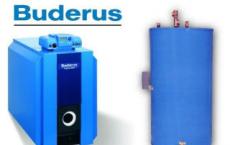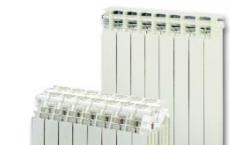Pipes for water supply in a private house. Description of the workflow. Benefits of connecting to a central network
Nowadays, there is the possibility of installing an autonomous water pipe in a private house, which greatly enhances the comfort of living. Now there is no need to carry heavy buckets and warm water in the basin to take water procedures. If the water pipe is installed in a building under construction, it is possible to take into account all the wishes at the design stage, and its implementation will be much easier. If the building is erected and has long been exploited, it is more difficult to arrange the flow of water, but it is possible.
Schematic construction of a water pipe in the house
The plumbing of a water pipe in a private house that is in operation requires the solution of additional problems of linking the pipeline to the existing room and the location of the plumbing fixtures. In addition, it will be necessary to knock openings in the walls, the floor and the foundation for laying pipes. All this creates additional difficulties, but if desired, is realized.
Water supply systems
Depending on the power source, there are:
- Centralized water supply system. It is arranged, if near the house there is a pipe of the central water supply, to which the water supply is supplied. Such a system is easier and cheaper to arrange, but in the future it will be necessary to pay for the water supply. In addition, it is difficult to control the quality of water.
- Autonomous water supply system. It requires considerable physical and financial costs, but the water quality is much higher. The autonomous water supply does not depend on the communal one at all. The source of supply are wells or wells, arranged on the plot.
A source drinking water, from which the fence for the water supply is made, should be no closer than 20 meters from cesspool, compost pile, toilet, septic tank, etc.
Pump and its connection
Most often, submersible or surface pumps are used to supply water to the water supply. The choice depends on the power supply of the water supply. First you need to decide whether it's a well or a well. The well is much cheaper, you can do this yourself. But its device requires a great deal of physical effort, and the water in the well, due to its small depth, does not undergo sufficient natural filtration and contains many harmful components. For wells up to 8 meters deep, it is advisable to install a surface pump, from it, lower the flexible hose into the water for intake. The pump itself can be installed in a house, utility room or directly near a well.
The well is arranged by specialists with the help of special equipment. They conduct research on the availability and quality of water. Wells are being built quickly, the water from it is always clean. It is worth the device wells is very expensive. To draw water from the well, a submersible pump is used, which descends to a greater depth in the water.
 Left - surface, right - submersible pumps
Left - surface, right - submersible pumps Plumbing schemes
There are two main schemes for plumbing:
- A serial connection scheme is used for temporary water supply, for a dacha or for a house with a small consumption of water. In this scheme, all plumbing devices are connected in series, from one pipe. If one sanitary appliance works, then in all others the pressure drops considerably.
- The plumbing scheme of the water pipe requires a large expenditure on the device and materials, but there is the possibility of simultaneous operation of several devices without loss of pressure in the pipe. In this case, water is supplied to the collector, and pipes from each sanitary device separate from it.
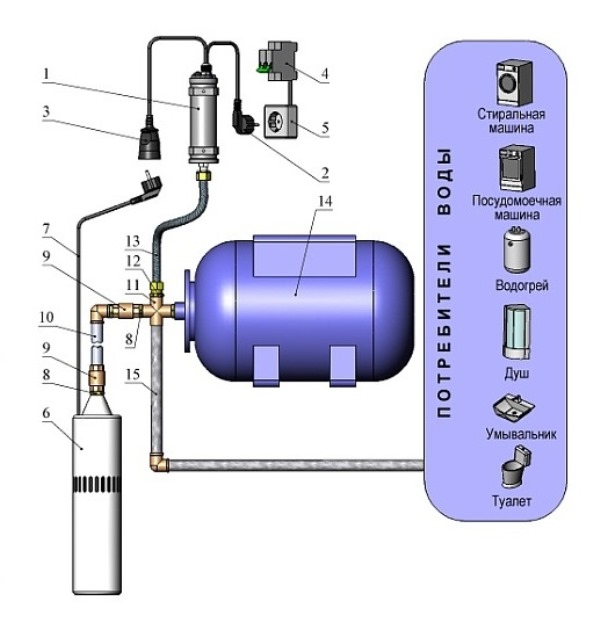 Wiring diagram of water pipes
Wiring diagram of water pipes - A control station that regulates the operation of the pump and disconnects it in case of danger.
- Cord with plug for connection to mains.
- A cord with a socket to which the pump is connected.
- Circuit breaker. In case of danger to the equipment, it turns off.
- Mains socket outlet in the house.
- Submersible pump, falls into casing wells, performs water intake and delivers it to the surface.
- A cord that provides power to the pump.
- Nipple for connecting pipes; has a thread from both ends.
- Non-return valve, designed to prevent return of water to the pump.
- Pumping tube, through which water is supplied from the well to the surface.
- Crossings, ensures the intersection of pipes in the same plane.
- Transition nipple, designed to connect pipes of different diameters.
- Flexible hose that connects to the control station.
- A hydraulic accumulator is a tank for accumulating water.
- Pipes for supply to consumers.
When laying pipes, the most laborious process is the preparation of the building structure. Following the layout of the gasket, it is required to make holes in the walls and continue the strobes. Thanks to them it will be possible to hide the pipes in the walls.
Types of pipes
Steel
These are the traditional pipes that have been tested for many years, which have been most widespread recently. Nowadays, they are being replaced by pipes made of modern materials that have better technical parameters.
Pros:
- Relatively low cost;
- Strength of material;
- Large range of fittings to them.
Minuses:
- Are exposed to corrosion;
- Formation of a deposit on internal walls of pipes;
- Good electrical conductivity: in the event of a wire break, the current is transmitted through a steel structure and can cause injury;
- Large labor costs for installation. Pipes are connected by welding, which only a qualified person can do, or a threaded connection. Installation is difficult and dangerous.
Galvanized
The product is much better and more reliable. The surface, covered with zinc, does not lend itself to corrosion, and deposits of salts or other minerals do not adhere to it.
Pros:
- High strength;
- Do not corrode;
- On the walls there is no sediment;
Minuses:
- High price;
- Conductivity of electricity;
- Corrosion may form in the joints;
- Complexity of installation.
Copper
Copper pipes have many advantages, but the cost of such a material is quite high. It is advisable to use them to beat water pipes in the interior of the house, tk. they have a beautiful appearance.
Pros:
- Do not corrode;
- Deposits do not adhere to the walls of pipes;
- Wide range of operating temperatures;
- Aesthetic appearance;
- Long service life.
Minuses:
- High price;
- Small assortment of fittings to pipes;
- Complexity of installation;
- Due to the thin walls of the pipe it is easy to damage.
Metal-plastic
These pipes have recently appeared on the market and are already widespread. They combine the qualities of metal and plastic.
Pros:
- Do not corrode;
- Do not conduct electricity;
- Ease of installation;
- Large range of fittings.
As a minus one can consider the fact that their service life is limited.
Polypropylene
These pipes for technical specifications have better indicators.
Pros:
- Low cost;
- Ease of installation. Soldering pipes is easy to do by hand without noise and dust, and soldering equipment has compact dimensions;
- Elasticity that prevents damage;
- Strength of material;
- Long service life.
The only drawback is that the connections can not be disconnected.
Polypropylene pipes for hot water must be reinforced with fiberglass.
 Pipes and fittings for water supply
Pipes and fittings for water supply Diameter of pipes
Choosing the right diameter is very important for the water supply system. If the diameter is small, there will be extraneous noise inside the water pipe, and if large, the pressure will decrease, and more energy will be required to provide the required pressure.
Determine the diameter based on the length of the water pipe:
- With a length ≤ 10 meters Ø = 20 mm;
- With a length ≤ 30 meters Ø = 25 mm;
- If more than 30 meters Ø = 32 mm.
The water flow is determined by the diameter and the number of plumbing fixtures. For these parameters, the required reservoir is determined:
- Ø 25 mm per 1 minute passes 30 liters of liquid
- Ø 32 mm per 1 minute passes 50 liters of liquid
Initially, it is necessary to determine the number of consumers and the length of the water pipe, based on this, the optimum pipe diameter is determined.
Installation of water supply
Installation is carried out from the power source to the consumer. The installation begins with the installation of the pump in the well, or pumping station for the well.
Pump mounting
The pump station is installed on the surface. You can put it in the house, which will simplify the control, but it is noisy in the work. The most suitable place for her – utility room.
The submerged pump is lowered into a deep well. A cable is connected to the unit to fix it to the required depth. With the help of an adapter or a clamp a flexible hose is attached, through which water is supplied to the hydraulic accumulator.
Mounting of the accumulator
The accumulator is designed to maintain a stable pressure in the water pipe and protects the pump from idling. Such a device is an optional element of the system, it is installed in two cases:
- to increase the pressure of water in the system;
- at faults with water supply.
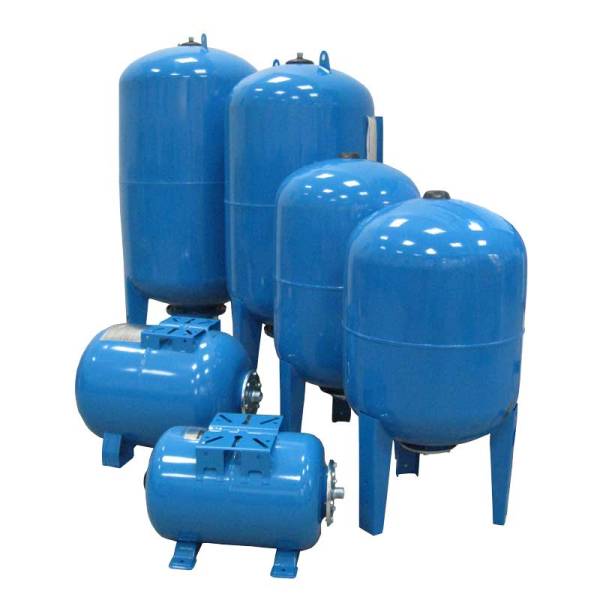 What do the accumulators look like?
What do the accumulators look like? The hydraulic accumulator is mounted at the highest point of the water supply system, but to be accessed. From the storage tank comes a tee, on which a stop valve is installed. Two other exits are directed to the cold collector and water heater.
Collector arrangement
The collector is designed for uniform distribution of head in pipes for all consumers. The number of collector pipes depends on the number of plumbing devices that are consumers.
 Collector cold water
Collector cold water
Cold water from the pump or filter is fed to the collector. Before it is installed a shut-off valve with a drain cock, so that if necessary, the collector can be disconnected from the pipe.
Filters are installed for better water quality. They must be installed in front of the collector and the boiler.
The second flow is directed to the boiler, which performs the heating of the water to the desired temperature and is fed to the hot collector where the distribution is distributed among consumers.
Each outlet of the collector has a shut-off valve and, in the case of repair work of one device, the whole system continues to operate smoothly. From the distributor to each device a separate pipeline of cold and hot water is laid. For a private house and apartment the best choice are polypropylene pipes.
How to solder polypropylene pipes with your own hands:
- The dimensions of the pipes for routing are determined, they are cut to the required length. Cutting is easily done with your own hands using special scissors. It is important to ensure that the blade of the scissors is perpendicular to the pipe.
- The edges of the adhesion are marked at the edges.
- The location of the spike must be carefully cleaned from dirt and dust.
- A nozzle of the appropriate diameter is installed on the soldering iron.
- The soldering iron switches on and heats up to the desired temperature.
- The tube advances in the tip of the soldering iron to the mark.
- After 7 seconds, the nozzle is removed and the tubes are connected. They need a little hold, but do not rotate.
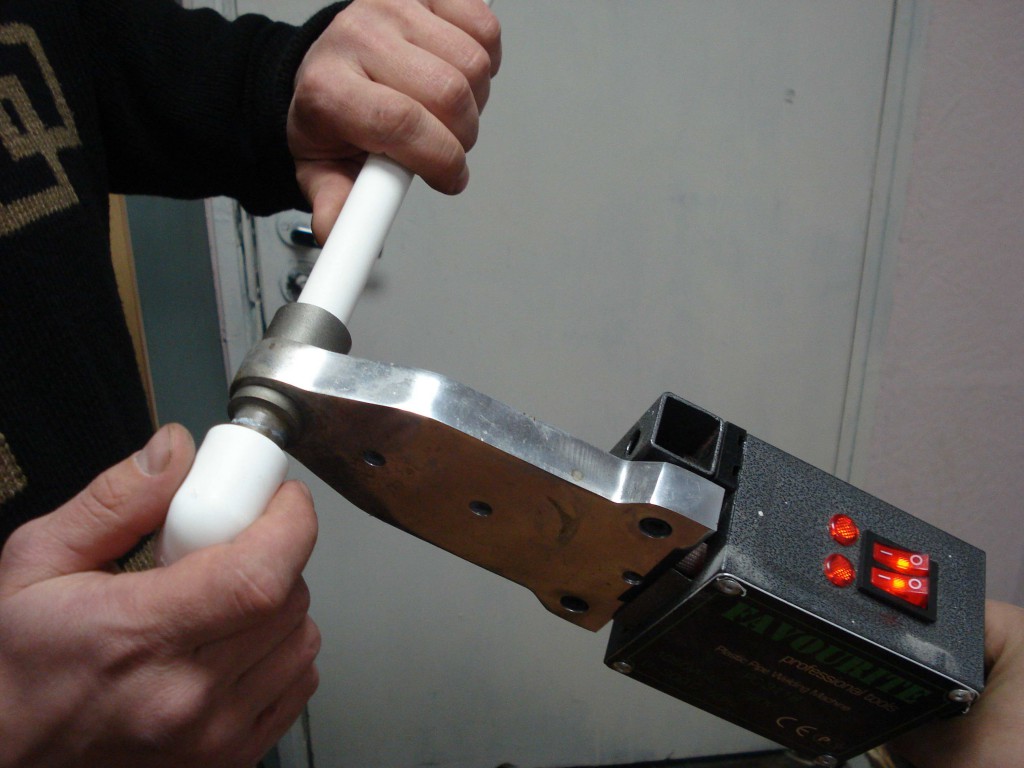 Spike of water pipes
Spike of water pipes Plumbing installation
The laying of the water pipe is performed from the collector to each consumer in the following sequence:
- The distributor has valves for each pipeline, if not, then a shut-off valve is installed.
- A pipe is drawn from the tap.
- The next pipe is connected with a fitting using a soldering iron.
- For the turn, a corner fitting is arranged.
- To fit the pipes to their size, they are cut with special scissors.
- To the wall clips are mounted, with the help of which the pipe is fixed to the wall.
- The devices of water consumption are connected (washbasin faucets, shower, sinks, CD, washing and dishwasher and others).
 Piping in the house
Piping in the house - If the pipes pass through the walls, then in the place of passage it is desirable to protect the pipe with a ring in order to avoid their contact.
- The distance between the pipes should be 200-250 mm for the convenience of repair work.
- It is necessary to fix the pipes with special clips mounted on the wall. Fasteners are installed in the corners, and on flat areas are located at a distance of 1500-2000 mm.
- It is necessary to minimize corners and turns in the pipeline.
To ensure that the water supply system can provide maximum comfort to residents, it is necessary to take into account a lot of nuances, correctly calculate all operating parameters and engineering units. It is very desirable to begin development at the stage of an architectural project. To make plans for life and establish the water supply of a private house with their own hands should, if not a professional, then a man who has penetrated into all the subtleties.
The water supply system is one of the most important elements in the improvement of the house. The essence of her work lies in the automated delivery of the required amount of water, for which the user now only needs to start the equipment, and then just periodically monitor.
The autonomous network, independent of the central water supply, must be competently designed and designed to ensure that the house was fully provided with water according to the needs of the owners. It is necessary to organize the system in such a way that water freely enters all water intake points.
Autonomous water supply systems consist of internal and external parts. Include the same branch of the pipeline, laid from the source of water intake to the points of draw-off, fittings, plumbing, pump, storage tank or hydraulic accumulator
For normal operation, the water supply system is equipped with devices and technical devices that provide automatic or partially automatic operation.
To automate the process, a hydraulic accumulator is used. It is used as a buffer tank for water storage and as a device for maintaining stable head. In the membrane tank there are two compartments - for air and water, they are separated by a rubber membrane. When the container is filled with water, the air chamber is compressed more and more, which causes the pressure to increase.
Reacting to increase of pressure, the electric relay disconnects the pump. As soon as one of the owners opens the tap, the pressure in the system begins to fall. The relay reacts again to the pressure drop and turns on the pump unit to replenish the consumed water.
The use of a hydraulic accumulator in the scheme of organization of water supply allows not only to automate the process of abstraction of water and provide its reserve. The service life of the pumping equipment is significantly extended due to the reduction of on / off cycles.
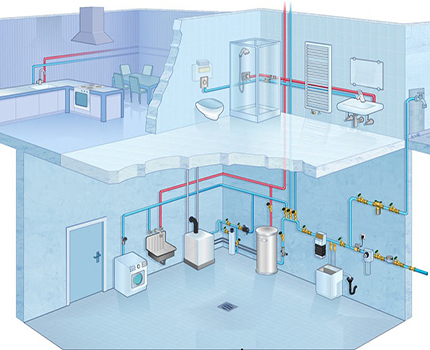
Water supply is the basis of life support at home. It depends on him how comfortable a person will be in his home
To properly select the system parameters, you need:
- Formulate requirements for the intensity and regularity of water supply. It is possible that in a small country house you can do with a system with a conventional storage tank and a minimum of plumbing fixtures.
- Identify possible sources, feasibility and cost of their construction, water quality.
- Select equipment and calculate options for laying utility networks.
A well-designed system requires professional installation, use of quality components.
Selection of sources and a water intake device
For the organization of a water supply system, houses are most often used the groundwater, giving preference to aquifers protected by watertight rocks. The points of their fence and the location on the suburban area need not be coordinated with the SES authorities, unless an artesian well is operated. To use surface sources, special justifications are needed.
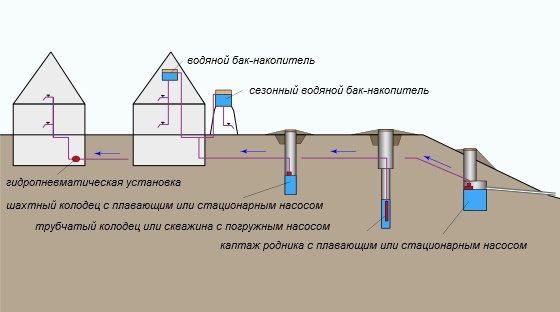
Water intake facilities should be built on an elevated site. Wells and wells with drinking water should be removed from places of potential pollution (latrines, compost piles, dumps, etc.) by at least 50 m (+)
The choice of the type of water intake structure depends mainly on the geological situation in the area, the depth of the aquifers, and the amount of water consumed. Most often, wells and wells are used, less often springs of springs, etc. The choice of a certain water-lifting equipment depends on the construction of the structure.
Facilities for water abstraction of the technical category are located no closer than 20 meters from the treatment systems, compost pits, street toilets of sewage pipelines, as well as other potential sources of pollution. The site for their device is chosen not to be flooded, excluding flooding and possible contamination of the source by flood waters.
The water intake structure should be surrounded by a pavement of a width of about 2 m, and then a clay lock 50 cm wide and 100 cm deep. Its ground part should be raised by 80 cm and have a cover protecting from precipitation and dust.
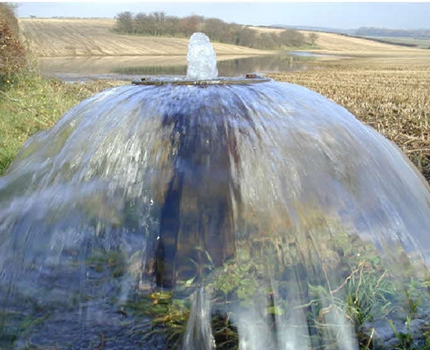
When collecting, transporting and storing water, it is necessary to use safe materials that will not degrade its quality
The use of a well for the organization of water supply
The choice in favor of the well is most often carried out if the water lies at a depth of twenty meters. Wells are of two types:
- Artesian. Can be a depth of 100 m or more. Occasionally there are gushers, if arranged in a decline. The disadvantage is the high cost of work. In addition, water can be highly mineralized, which will adversely affect the operation of the pump and plumbing fixtures.
- Wells shallow deepening (including Abyssinian). Their installation costs significantly less, but the drawback is that over time they can become silted, especially if they are not used constantly. To raise water requires the installation of special pumping equipment.
Wells are the most common water intake structures. Their design may differ, but the general principle of the device is preserved, they consist of such parts:
- Estuary and aboveground part. By rules, the mouth is settled in an underground chamber - caisson. If a caisson is not used to prevent rainwater from seeping into the well, a sealed headpiece is constructed.
- The trunk, whose walls are reinforced with casing from steel alloy, plastic. Sometimes asbestos-cement pipes are used to equip artesian wells at great depths.
- The water intake part, which has a settler and filter. In rock formations one can not use filtering devices.
Around the structure is recommended to make a blind. For wells that are silted up, it is advisable to equip a special place for draining water to prevent erosion during the washing of the mine. If the place can not be arranged, it will be necessary to rent a sewage machine to remove water from washing.
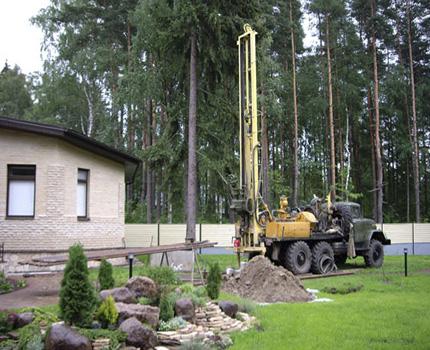
Drilling wells requires a place for access and manipulation of large equipment. Often the absence of such a space makes it very difficult to mechanically design a water source
The use of wells as a source
The well is constructed mainly from concrete rings, masonry, sometimes their walls are made of wood. It consists of an aerial part with a derived vent pipe, a trunk, a water intake and a water body.
Water inside the well can come through the bottom or walls, or at the same time from both. If the supply goes through the bottom, buried in sand, then it is supplied with a gravel bottom filter. When water enters through the wall, special "windows" of porous concrete are arranged, which are covered with gravel as an additional filter.

The construction of the well does not present great difficulties. Therefore, if there is a need to save, then dig it out and then serve it yourself
Arrangement of capturing chambers using a spring
Device protective structure over the spring is little different from the design of the well. In them water can also flow through the bottom or walls, which are equipped with filters. In rock formations, filtration is not required. If there are suspended particles in the water, then the chamber is divided in half by a partition, one compartment serves for settling and cleaning from sediment, the other for water intake.
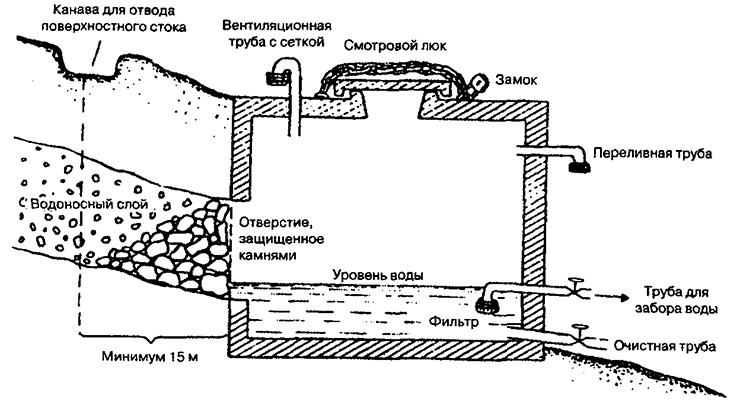
If you do not organize the drain from the spring, then, under conditions of weak water consumption, the source can stagnate and the water in it spoil (+)
For the exit of excess water at the largest source of the source, an overflow pipe is provided in the wall of the chamber. At its end, a valve is installed, which allows water to pass through, but prevents the entry of debris into the spring and the penetration of rodents.
Equipment for automatic water supply
Selection of the method of arrangement and installation of the water supply system a country house begins with an assessment of the type of water intake structure, its depth and other characteristics. The automated system includes:
- pump or ready pump station;
- a filtration system for water purification;
- storage and control capacity;
- external and internal pipeline;
- devices for automatic regulation.
When installing tanks and pumps, the requirements of the equipment manufacturers must be strictly observed.
Regulating and storage tanks for water
Tanks for water supply are distinguished on the principle of operation:
- Pressureless non-hermetic tank. It is produced mainly from polymeric materials. Helps create headroom by placing it at the highest point in the system. The higher the storage tank is installed, the greater the water pressure will be in the system. Lifting the tank for each meter increases the pressure by 0.1 atmosphere.
- Hydropneumatic tank. Inside it is divided into two compartments by a membrane. Creates pressure thanks to compressed air in one compartment, which through the rubber membrane puts pressure on the water in the next compartment.
The pressureless tank is installed in an illuminated ventilated room, the temperature of which does not drop to negative values. Under the container, pallets are installed to protect against small leaks. The tank is equipped with a removable cover and is equipped with a stop valve.
One of the characteristics of the operation of pumping equipment is the frequency of the system switching on per unit time. This indicator is fundamental in the choice of hydraulic accumulator. In submersible pumps, the allowable interval between inclusions is greater than that of surface pumps. To join them less often, it means that the tank should be bigger.
To work in tandem with surface pumps, they often buy membrane tanks capacity from 12 to 24 liters. If in populated area there are interruptions with electricity, it is recommended to install a hydraulic accumulator for 250 or more liters, so that you can pump and store a reserve of water for a while.
Hydroaccumulators are placed in chambers under the ground, in basements, store rooms, in which the temperature does not drop below zero.
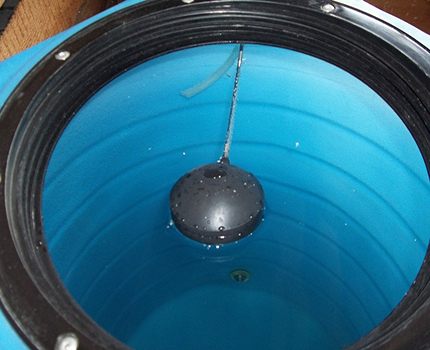
In a system with a storage tank without pressure tank, the water supply process is automated by means of a float valve and an on / off sensor
Purification of tap water from impurities
The method of purifying tap water is selected based on the results of its analysis. Analyzing them and identifying the most acute problems, they prefer this or that device.
For example, if it is necessary to clean rust, then filtering through special replaceable cartridges for filters is used for this. De-ironers also remove the smell of hydrogen sulfide and manganese. With the removal of fluorine from the water, a reverse-osmotic filter, which is used to make potable water in the kitchen, will help.
For a more thorough purification, a special water treatment station can be used. If it is necessary to reduce the stiffness, filters are used softeners. When using well water, it is recommended to use an ultraviolet disinfectant.
Types of pumping equipment and selection features
For autonomous water supply, pumps can be used of different types: submersible, vortex, cantilever, console monoblock, as well as manned pumping stations. When choosing a water-lifting equipment take into account:
- Source rate. It should exceed the consumption of water in the house.
- Type of water intake structure and depth of aquifer. For pumping from sources of depth up to 8 m, apply surface centrifugal pumps. They are placed in the basement or separate rooms of private houses, underground chambers or shafts. The water is pumped from a large depth by means of powerful submersible pumps.
- Required pressure in the system. The head of the pumping unit is determined by summing the values (in meters): the height of the rise from the level of (dynamic) water in the well to the highest placed sanitary device, the head loss at the highest point, the necessary head at this point.
- Estimated water flow. Calculate, based on the number of plumbing points and the number of residents. This indicator affects the choice of equipment performance.
Models of submersible pumps are produced for installation in both deep and shallow wells and wells. They come in different capacities and diameters. Surface pumps are characterized by less pressure, so they are used for shallow sources - wells and springs. Such devices the manufacturer often complements pressure tanks and automation, then realizes as ready pumping stations.
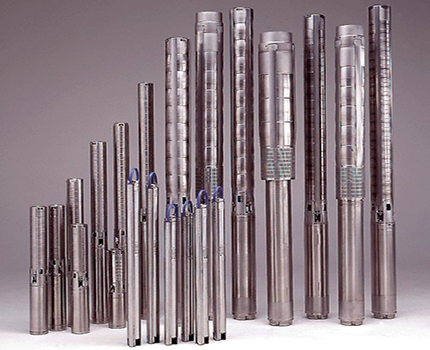
Devices for wells are produced in the form of a long, narrow cylinder that can be freely lowered into it. Sludge aggregates are more dimensional
It is desirable that any pumping equipment be equipped with protection against work without water - this will prevent its overheating and breakdown in the event of a decrease in the level in the source or damage to the pipeline.
Separately, it should be said about the ejector - a device that facilitates the operation of the pump when taking water from a great depth and / or increases the head. It is installed inside or outside the pump, it allows to increase its capacity and spend less energy on pumping out water.
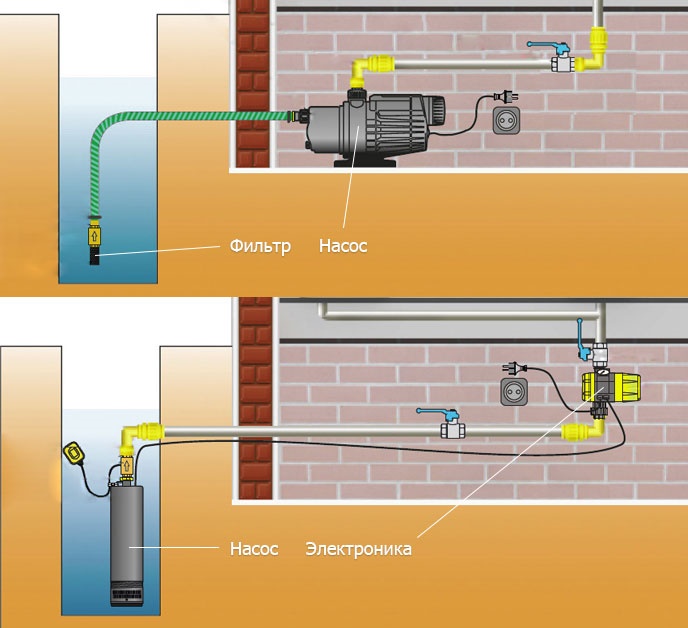
The choice of the pumping unit is mainly focused on the marking of the water mirror in the source and the type of the water intake structure. For pumping water from the wells, surface pumps are used, for the extraction from the well - submersible
Control and adjustment devices
The pressure gauge is used to control water pressure. It should be accurate, because even a small discrepancy in the indicators will lead to incorrect configuration of the equipment. You can use appliances designed for installation in a car.
The pressure switch is responsible for disconnecting and starting the device. In addition, it effectively protects the system from excessive pressure generation, regulates the frequency of operation of the pump and prolongs its service life. When connecting the relay for the first time, it is most likely not necessary to adjust it, it already has factory settings. But at the slightest deviations in the equipment operation, the relay needs to be checked and adjusted one of the first.
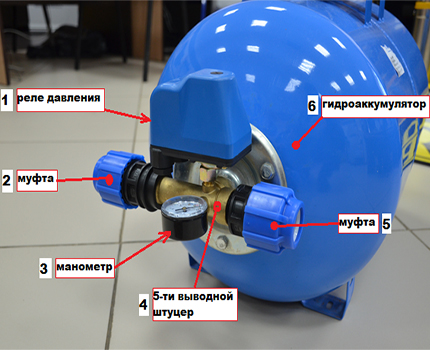
Without measuring and regulating devices, such as pressure switches and manometers, it is impossible to monitor the operation of an autonomous water supply system
Priority and scheme of installation of water supply network
Like all work with engineering systems, the water supply of a private house must be carried out in a certain sequence. Having equipped first of all the water source, the installation is carried out:
- external and internal pipeline;
- pumping and additional equipment;
- water purification filters;
- distribution manifold;
- hot water device.
The final stage is the connection of plumbing fixtures.
The order of installation of pumping equipment
The method of installation of water supply systems with submersible and surface pump slightly different. Surface centrifugal pumps (pumping stations) are placed in a heated external branch or in the basement of a house, pit, etc. The submersible pump is connected to a hose and power cable, lowered into water and suspended on a nylon cable, usually included in the equipment of the unit.
Installation submersible pump perform in this order:
- Before you lower the pump, measure the hose and cable. Between them, they are connected with plastic clips every 4 m and connected to the pump.
- While holding the cable (you can not hold the pump on the hose or cable), lower the pump to a predetermined depth, securely fix it. The manufacturer of the model indicates the allowed distance to the bottom.
- Over the casing, the headband is attached. Hose and electrical cable lead out through the central hole, tie a rope. Finally, tighten the bolts, sealing the structure.
The next step is the laying and installation of the supply pipe.

If the well is not very deep, then the nylon cable that holds the pump is tied to a rubber harness fixed to the head. It will damp the pump vibration
Installation of external pipeline
For outdoor laying water supply network most often use polyethylene - PE (or HDPE), metal-plastic pipes. The latter is stronger, but worse bends. Much less often used steel without zinc coating or galvanized, with anti-corrosion treatment.
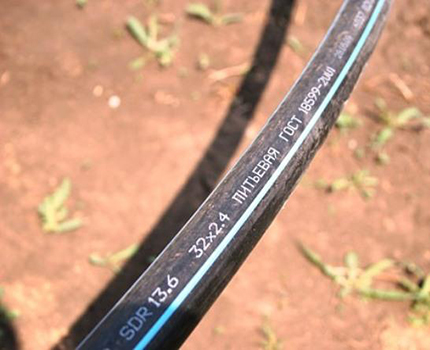
Quality HDPE pipe should be marked, it does not have foreign spots and streaks, an unpleasant chemical smell
The pipeline should be laid half a meter below the freezing level. With a less deep stowage use a heater. Connect the pipes with collet fittings without the foamed tape and other seals.
Installation of the pipe is carried out as follows:
- dig not a wide trench to the depth of freezing and plus half a meter;
- at the bottom arrange a pillow from the packed career or river sand;
- level the bottom with a slope of 2-3 cm per meter;
- insulate the plumbing site laid above the depth of seasonal freezing to the entrance to the foundation of the house;
- lay the pipe and fall asleep with clean sand without clay inclusions.
When laying pipes it is best to avoid joints and do not use fittings, otherwise the maintainability of the entire pipeline deteriorates. If nevertheless it is necessary to make a branch under the ground, then it is better to use fittings for welding. The result is a soldered, monolithic connection without threads.
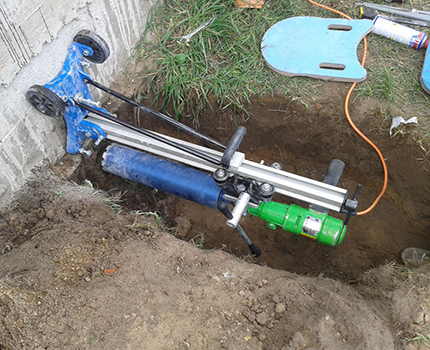
It is better to put the pipe into the foundation of the house through a pipe of a larger diameter, the so-called sleeve. This will facilitate the repair of the mainline if necessary, and sometimes, if the pipe is not very long, it will be able to extract it without digging up the trench
A device summer water supply for watering, provision of premises intended for summer use. Such a pipeline is sometimes laid over the ground.
If the summer water delivery system is buried, then it is possible to drain for conservation during the cold season. For this purpose, a standard slope towards the source of water intake is arranged. Some types of pipes must be hidden from sunlight and exposure to negative temperatures. Therefore, even for the temporary summer operation of the pipes made of them, it is better to lay a water pipe underground.
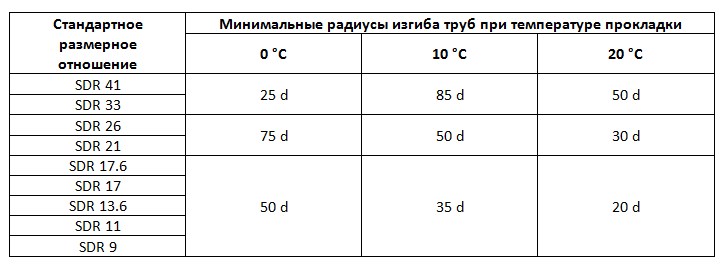
When laying HDPE pipes, take into account the minimum permissible bending radii. They depend on the SDR index (the ratio of the diameter of the pipe to the wall thickness). Otherwise, the radius of the pipe will greatly decrease at the bend point, which will increase the pressure in this area and the load on the pump (+)
Installation of the inner section of the water supply system
The scheme and installation of an internal water supply network for different dwellings can vary greatly. Based on the individual layout and zoning of the house, its number of storeys and the number of sanitary ware, an individual scheme is drawn up for the water supply of the private house. But in general, the sequence of actions can be described as follows:
- According to the predetermined marking, the brackets for fixing the pipes are fixed. If concealed installation is supposed, then the walls are pre-shrouded, and then the fasteners are installed.
- At the entrance of the pipe into the building, a ball valve is installed.
- Mount the collector, connect the pipes to it, dividing them into several circuits.
- Metal-plastic pipes connect the press with fittings, polyethylene and polypropylene - by welding.
Before embedding the strobes, check the system's viability. Inspect the quality of the connection of pipes, evaluate the operation of the pump and regulating automation.
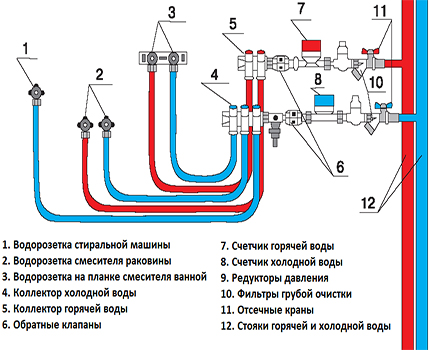
The division into several circuits optimizes the pressure, so when using one plumbing fixture, the pressure in the other sections will not fall
Video materials on the topic of water supply installation
Important nuances on the device of water supply in the house from a specialist:
Laying an external pipeline from the foundation of the house to the well:
All about the device of water supply:
When designing a water supply system, one must take into account that the more complex it is, the more comfortable it is to use. But a simple system is more reliable, less likely to be out of order, available for self-repair. Therefore, when drawing up the scheme, it is important not to overestimate one's strengths and determine the most important functions that the water supply system must perform.
Drawing up schemes for communications is a very important and responsible moment, which can not be treated irresponsibly. The plumbing of a water pipe in a private house by one's own hands can not be superficial, no excuses are unacceptable here.
The creation of a scheme is the first step for those who decided to equip communications in their home. Consider the entire construction, its main elements.
- pump designs;
- set with filters;
- the device of the boiler;
- do not do without sewers;
- several water users.
On the document, it is necessary to designate a common path through which pipe products will be laid on the territory of the house. And also - the location of each element individually. Well, if the diagram owner of the house will not forget to show the distance. Then it will be easier to organize a water pipe in a private house with your own hands, make the necessary calculations.
Water supply in a private house with own hands
There are two ways in which you can create the necessary schema:
- Connection of a collector type.
- Consecutive connection of each consumer.
Laying a water pipe in a private house with their own hands must take into account that the circuit itself should consist of the following several components.
- Water intake is carried out from wells, wells.
- Do not do without the so-called pumping station. The pipe is laid in the ground from the place that became the source of water. Then it is fed to the design of the pump itself. To prevent water movement in the opposite direction, it is necessary to put in advance on the device check valve.
- The hydraulic accumulator is responsible for pumping water.
- It is permissible to use a tee, which has a stopcock, on the outlet pipe, after the hydraulic accumulator itself. One of the pipe structures allows satisfying technical needs, and the second one can be used for household needs.
- The systems responsible for cleaning and preparing water - that's what the pipe that is used for household needs must be connected to. Being engaged in such a question as the installation of a water pipe in a private house with their own hands, it must be remembered that water from underground sources rarely gets to us without impurities. Therefore, its cleaning requires as much attention as possible.
- When the filtration systems are processed, one more tee is being assembled. It will allow to separate the cold and hot water separately from each other.
- Connection of the pipe structure, over which the hot liquid is transported. It must be connected to the water heater.
- Then it moves to the collector, after the water heater. From it the pipes diverge further, throughout the territory of the house.
This is a typical scheme that remains unchanged in any situation. But the installation of a water pipe in a private house with their own hands may include other complementary elements.
We turn to the installation of water
For future pipes, you will certainly need to create the right number of holes in the walls. This is the most difficult work in this process, a lot of garbage is formed. In addition, the work does not require any physical effort. You will have to go through the following steps:
- Pipes are cut, connected.
- Each user is connected.
- Connection to the collector.
- A station with a pump is installed.
- Connecting the systems responsible for filtering.

Autonomous water supply
Although the time for such work can go far enough. But even a novice is able to equip a domestic water supply with his own hands, the photos on our website will make explanations more clear.
Choosing the right pipe material
A lot of buyers have already evaluated the high quality of polypropylene pipes, high reliability.
It is necessary to perform additional reinforcement for the structures through which the hot water. To do this, you can use a variety of materials, including aluminum and fiberglass.
In many respects, the cost of laying will depend on the material from which the pipes are made. The main thing is to choose the product with the most optimal ratio between this indicator and the quality level.
Diameter of pipes of a waterpipe
This factor is no less important than the materials from which a water pipe is created in the house with their own hands. If the indicator is too small, turbulence in the water flow will occur. And this means that the design at work will make a lot of noise. And on the walls in large quantities will appear pollution, sediments. 2 m / s - the maximum speed with which water can move through the pipes. It is necessary to remember this by choosing suitable products.
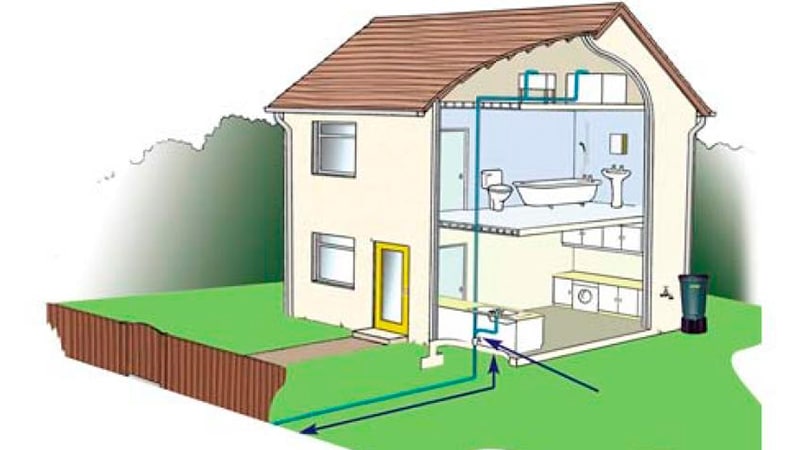
We are running water in a private house
If you choose the right options, then the work of all consumers will be effective as much as possible.
- 75 liters per minute will pass products to 38 millimeters in diameter. It's 1.5 inches;
- 50 liters per minute - so much is missing a tube of 32 millimeters, 1.25 inches;
- 1 inch or 25 millimeters - diameter, through which can pass 30 liters per minute.
In addition, it is important to remember what the total length of the pipes can be.
- Pipes with a diameter of up to 20 millimeters will be an excellent addition for short pipelines, less than 10 meters.
- With a length exceeding 30 meters, it is recommended to use pipes 30 mm in diameter.
- 25 millimeters - an ideal indicator of diameter in pipelines is not more than 20 meters.
In our homes, water users sometimes work several times at once, such situations have ceased to be a rarity. Individual calculations are carried out along the diameter for pipes inside the collector, with support for these data. Otherwise, the competent installation of a water pipe in a private house becomes impossible.
The calculation of water every time is carried out in different ways depending on how many people in the family.
Pipes from polypropylene - welding
This is the simplest example, on the basis of which you can generally consider the process of welding.
In case of cold water It is necessary to take walls with a thickness of up to 2.8 millimeters, and the diameter of the pipes should be in the limit of 25 millimeters. Hot water should flow only through reinforced pipes, with walls at 3.2 millimeters, and a total diameter of 25 millimeters.
The main result is the presence of a perpendicular connection for those who decided to weld pipes on a polypropylene base. A piece with a joint is easy to cut off if the result is not liked for some reason. After that you can continue to work.
When the welding process is completed, the pipes should cool down for a while. As a starting point, it is better to choose one of the water consumers. The adapter will allow to connect the pipe to the consumer, thus a threaded connection is used.
- The ball-type valve is installed where the adapter and hose are located. Without this tap it is impossible to shut off the water, if necessary. Continue to move towards the collector. It is important to observe only a few basic rules.
- The option is not permissible when the pipes pass along the same paths as the building structures. Especially this applies to partitions and walls. It is better to ensure that the pipes are inside special glasses, if you can not do without it at all;
- The distance to the wall should not be less than 20-25 millimeters. Then it will be easier to repair or replace when necessary;
- An easy inclination towards the crane is done when the drainage devices are mounted;
- The pipe is located at a distance of not less than 15 millimeters, when the outside corner is bypassed. Internal demands to retreat more: 30-40 millimeters;
- Special clips should be used to fix the pipes on the walls. Special attention is paid to the angular joints. Clips are located at a distance of up to a half to two meters, if it is a question of straight sections.
- PND fittings are tools that will help us to connect polypropylene pipes at an angle, even if it is 90 degrees. In the solution of this question, tees with transitional and identical diameters become irreplaceable.
- The pressure is lost less if there are practically no corners and turns in the highway.
- When the pipe is connected to a water pipe, it is necessary to do without shut-off valves. This will help in the future to turn off one of the consumers if repair is needed.
Pumping station and indoor plumbing
Without a pumping station, it will not be possible to connect the water supply to the source of water. It does not matter if a well or a well is used as a well.
As for the pumping station itself, the best place for it is the premises technical purpose with heating, ground floor, basement or house area. Thanks to this solution, the water supply will be available even in severe frosts. Then low temperature indicators will not be terrible and the design itself.

Water supply in a private house - installation from a well
A brass fitting with a 32 mm diameter should terminate the pipe connecting the pump station to the place that became the source of the liquid.
A tee with a drain cock is connected to the fitting itself. This will disable not only the specific consumers, but also the supply of water when the need arises. After this, you can proceed to connecting the non-return valve. You can use a regular angle of 90 degrees, if you want to make the pipe turn.
A quick mix of "American" will help to connect all the necessary elements after that. This concerns, first of all, ball valve and a strainer.
A damper type tank must necessarily be present, the pressure relay is an important requirement for any pumping station. The pressure switch is connected from above, in the throttle of the water intake place the pump, and the other part of the devices - on the territory of the house. The damper tank, hydraulic accumulator are located in the lower part of the structure.
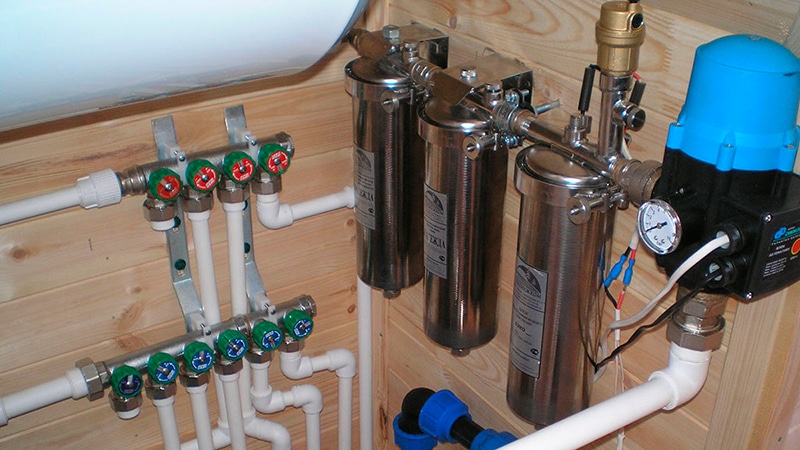
Installing a water pipe in the house with your own hands
It is also necessary to use a sensor that protects the structure from the so-called "dry running". Behind rough cleaning responds separate filter.
After this - the transition to a pipe, which has a diameter of 25 millimeters.
It is necessary to check how well the connection is made before proceeding with further work.
A little about accumulators
Due to the accumulator, the pressure in the system maintains a stable level. The same device allows you to turn the system on and off as needed.
Within three bars there is a pressure indicator in the system, for example, when the accumulator is completely filled with water. When you turn on the consumer from the house, water simply leaves. Because of this, the pressure indicator becomes smaller. After that, the relay starts working, the same applies to the pump. The water is pumped again until the pressure reaches three bars.
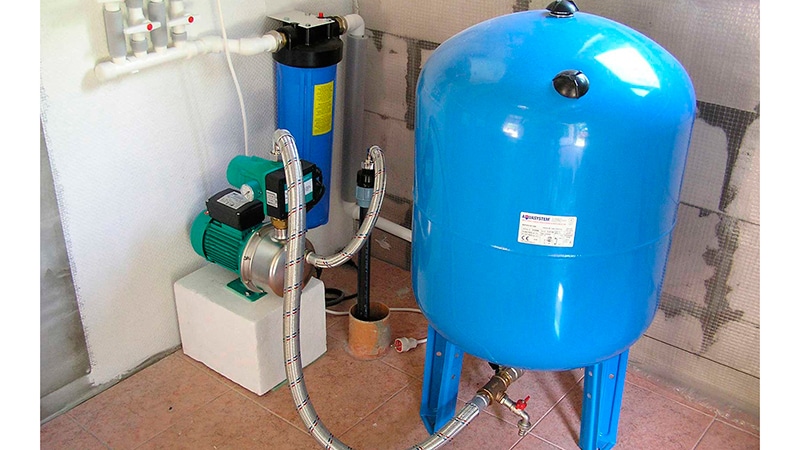
Hydroaccumulator in a private home for a water distribution system
Tanks have a different volume, from 25 to 500 ml. In each case, the family chooses suitable option according to their needs. When the water pipe is installed in a private house, it is not necessary to always have a hydro accumulator. When working on the floor, which is the highest in the house, for example, you can install a storage tank. In this case, the weight of water will create certain pressure, under which it reaches every consumer.
Water appears in the water treatment system immediately after it was in the accumulator. The cleaning devices themselves should be at least 0.5-1 meter away from it. It is also important to install the collector and boiler correctly.
Installing a water pipe in the house with your own hands. Accumulator in a private house for a water distribution system. Autonomous water supply. Water supply in a private house - installation from a well. We conduct a water pipe in a private house. Water pipe in a private house with our own hands. Water supply scheme in an honest house.
2Increase the comfort of living in a country house, in the country or in the countryside, by running your own water supply.
This is not easy, especially if the building was built long ago and its design did not provide for such changes.
But in any case, the running of a water pipe in a private house can be done by oneself, without using the services of professionals.
And it is necessary to start this activity with the extraction of useful information - what materials and tools are needed, what kind of water supply scheme it is better to use in one or another case, what kind of technical support is needed.
In advance, it is necessary to make a diagram of the water connection. And do not be justified by the fact that you need a water supply only for the kitchen - the scheme is still needed, since in detail the water pipe looks rather difficult.
How to build a water pipe in a private house?
Therefore, it is better to draw a diagram of laying pipes and sewerage taking into account all the elements:
- consumers of water,
- collectors,
- boiler,
- filters and pumps.
On the diagram it is necessary to designate the location of these units and structures, as well as the direction of the pipeline through the premises in the house.
All this needs to be done on a scale and with dimensions. Detailed scheme simplify and accelerate the calculation of materials for private water.
The laying of pipes is performed in one of two ways:
- Serial connection.
- Collector connection of water consumers.
The first method is good for a small house with 1 - 2 residents. For a cottage or a country house, this scheme is too low-power. The principle of its operation is as follows: water flows through the main pipeline to the house, and next to each tap-point (tap, mixer), a tee is installed for tapping to the consumer side.
Therefore, if you use several cranes at once, then in the most distant will be low pressure, which may not correspond to the needs of the tenants.
The second method works as follows: water pipes are diverted from the collector separately to each water point. Therefore, the water pressure will be almost the same for each tap or other consumer in the house.
Losses in pressure will be the same, as this will be caused by the distance to the pumping station, but they will be much less than when using the first method (serial connection).
If you dilute water through a collector, it will be more expensive because of the greater number of pipes, but convenience is more important. Therefore, consider the collector connection in more detail.
 The scheme of water supply in the house can be represented in the form of such units and elements:
The scheme of water supply in the house can be represented in the form of such units and elements:
- Source of drinking water
- central water supply
- well
- well.
- Pump or pump station.
From the point of connection to the water source, a pipeline is laid and connected to the pumping station. certainly.
- Hydraulic battery for water.
it expansion tank with a membrane that maintains pressure in the water supply system. Its use allows to build with a submersible or surface pump.
The hydraulic accumulator is needed to maintain and smoothly change the water pressure in the water supply system.
- After the hydraulic accumulator a tee and a stopcock is installed. Tee is needed to distribute the flow of water - to the house and to household needs (garden, garage, and so on).
- The water supply for the house must have a water purification system and its preparation, because any source of water will contain any impurities, and possibly harmful.
- After the filters, a tee is installed, which separates the cold water and the preparation of hot water.
- Cold drinking water is connected to the collector. Shut-off valves must be installed on each consumer line.
- The hot water supply must be connected to the heater (boiler, heating element, boiler, stove).
- Further, hot water is supplied to the collector for DHW, which distributes the pipes around the house.
In the water system, additional nodes and elements can be installed, but the standard scheme for connecting the water supply to the private house and its sequence must be permanent and unchangeable.
Materials and tools for installation
- Copper pipes.
They are considered the best for a water supply system, but they are also the most expensive.
This water pipe does not lend itself to corrosion, is not afraid of ultraviolet radiation and aggressive biological environment, it can withstand high pressure and changes in ambient temperature, is not afraid of harmful and toxic impurities, it has good heat transfer.
These are aluminum pipes that are covered from the inside and outside with polyethylene. Smooth surface does not allow rust to develop and accumulate mineral deposits. The polyethylene layer on the outside protects against condensation and solar radiation.
Disadvantages - deformation at a temperature above 95 ° C, sensitivity to freezing of water, it is impossible to bend at an angle greater than 90 ° C without using fittings.
- Iron pipes.
Durable, reliable, but quickly rust from the inside and outside. When installing steel pipes, you must either cut the thread on each element or use welding.
Now they are the most popular in the construction of private water supply.
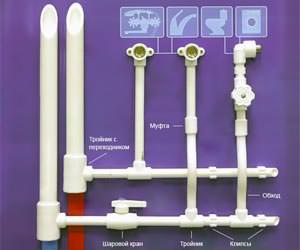 Polypropylene pipes have excellent operating parameters, they are not oxidized, can be operated for up to 50 years, they are easy to assemble, and the connections are so reliable that the pipeline can be hidden even under a layer of plaster.
Polypropylene pipes have excellent operating parameters, they are not oxidized, can be operated for up to 50 years, they are easy to assemble, and the connections are so reliable that the pipeline can be hidden even under a layer of plaster.
This can be done in the department of the sanitary-epidemiological station, in which the chemical and biological composition of water is checked, the fluid meets the requirements of SanPin and GOST.
And most importantly - for the construction of a well, the permission of state organizations is not needed.
Water from the well
An artesian or simple well is also a source of clean drinking water. Water is taken from a great depth, so it is much cleaner than in wells, and has a stable chemical composition.
In water from a well, there are often no harmful impurities and compounds, almost no microorganisms.
That, the project of works needs to be coordinated. It is not easy to obtain such a drilling permit, because the state requirements to the quality of the project are the same as the requirements for centralized water supply.
 But, judging by practice, this does not prevent homeowners from carrying out an autonomous water pipeline on the site. What do you need to know when drilling a well and conducting such a water pipe?
But, judging by practice, this does not prevent homeowners from carrying out an autonomous water pipeline on the site. What do you need to know when drilling a well and conducting such a water pipe?
- Your requirements for quality and water flow from the well. This will determine the cost of works and equipment for the water pipe, the costs of the filter and casing string.
- Equipment for water lifting should be powerful enough to provide water supply to consumers with the necessary pressure. Therefore, a deep pump must be installed in the well.
Select the design and determine the location of the well in accordance with the regulations.
According to these norms, the first sanitary zone is 30 m. But most often the size of the land is smaller, so you need to choose a location as far from the drainage mains and outbuildings.
Additional equipment for water supply
Standard stand-alone water supply includes the following equipment:
- Pumps and pumping water-lifting equipment of various types.
- Pipelines with fittings, mixers and faucets.
- Equipment for monitoring and in the system
- The equipment for water treating.
- Electric part of the water supply system:
- protective automatics,
- wiring,
- switchboards.
Very often a pumping station is used to supply water to the house or land.
Usually, if the well or well is shallow - up to 8 m, or with a relatively small water consumption.
The pumping station also consists of elements that relate to autonomous water supply. It:
- Pumps of different models and types.
- Storage tanks with different volumes and different configurations.
- Electric boilers, heating elements, water heaters, etc.
Pumping station
To connect private vacation home to the water supply, a pumping station is used to pump water from a well or well into a water supply system or into a reservoir.
Pumping station is a complex of pumping equipment, automated and allowing to create the required pressure in the water system with the indicated water flow.
The pumping station should be located as close as possible to the points of water consumption - in the house itself, in the basement or basement, in a separate room, but always in a heated place, so that the water does not freeze even in severe frosts.
Connection of the pumping station
From the water source to the pumping station, a pipe ending with a fitting (brass or bronze) with an adapter of 32 mm in diameter should fit.
To the fitting is connected a tee and a drain cock, which can block the supply of water during repair or a water supply accident. A non-return valve is connected.
To turn the pipe you need to use a 90 ° corner. It is best to connect the water pipe with a quick connection, which is called "American":
- Connects ball valve on the supply of water.
- It is connected (with a metal grid).
- The "dry run" sensor of the pump is connected.
- Then the connection to the 25 mm pipes is connected and made.
The pump station must have a damper tank and a pressure switch.
But if the pump is installed in a well or a well, and all equipment is in the room, then the pressure switch must be connected from above the pipe, and the accumulator or damper tank - from below.
Now you need to check the work of the station - start the pump. If there is no pump-out, check the connections for correctness or the accumulator for pumping.
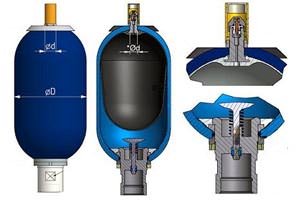 A hydraulic battery is a sealed container, divided into two compartments. In one compartment water, in the other - air. The hydraulic accumulator maintains a constant pressure in the water supply and regulates the operation of the pump as required.
A hydraulic battery is a sealed container, divided into two compartments. In one compartment water, in the other - air. The hydraulic accumulator maintains a constant pressure in the water supply and regulates the operation of the pump as required.
If we consider the example, then when the accumulator is filled with water, the pressure in the water pipe will be 3 bar. If the house is opened with a tap, the water from the accumulator starts to go off, the pressure drops, the relay will work and turn on the pump. Thus, the pressure in the tank rises again to 3 bar.
The volume of the tank can be from 25 to 500 liters - it depends on the number of tenants in the house. But it is not necessary to carry water in the house with a hydroaccumulator. You can simply put any large capacity in the attic or the last floor. The water in the system will always be under pressure, which ensures its mass and volume.
But any tank will be small for the operation of the washing machine. Therefore it will be necessary to install the accumulator.
Water treatment and treatment systems
Water from a well or well must be checked in the laboratory for the presence of mineral salts and other impurities. From the quality of water will depend on the choice of filtration systems, and other devices and units for water treatment.
From the accumulator water enters the purification system. Devices for water treatment should be located in 0,5-1 meter from a damper tank or a hydroaccumulator.
After the filtration system, water is divided into two streams:
- one water pipe leaves in a collector for cold water,
- the second is sent to a boiler or another DHW system.
At the inlet of the cold water collector, it is absolutely necessary to put a tap for draining the water and a shut-off valve.
Each manifold pipe must also be equipped with a drain and shut-off valve. How many pipes in the collector are needed is determined by the number of water points in the house.
A plumbing line in a private house will be considered complete if the house is secured and hot water. Therefore, a pipe connected to a boiler, a heating element or a boiler must immediately be placed under a boiler with a drain cock and an expansion tank.
At the outlet of hot water from the boiler, you must also put a drain cock. Then, the hot water is connected to the hot water collector, and hot water is already diverted from the collector to all the rooms.
Self-construction of the water main in the house can be considered complete. Before operation, it is necessary to check the system for operation and absence of leaks along the entire length of the water pipe. If everything is in order - use your health.
If the source of water is a well or a shallow well, then in the water supply system of the house there should be:
- Pumping installation. It supplies water from the source and maintains the pressure in the system within the specified limits.
- Accumulator. It does not allow a rapid drop in pressure when the crane is opened. Reduces the number of starts of the pumping unit.
- Cleaning station. It is possible that the water will not be of drinking quality, which is checked by laboratory analysis in SES. And if the water quality is acceptable, then we need simpler filters.
Water distribution schemes inside the house
There are two possible layout schemes for the pipeline inside the house:
- Sequential
- Parallel.
Therefore, such a scheme is not used for a long common pipeline and a large number of consumers who can work simultaneously.
But this simplest scheme with a minimum length of pipes.
The parallel scheme provides for the installation of a short pipe-collector, from which long pipelines depart, each to its consumer (or to a small group of consumers). This is a more popular option, since all consumers will have approximately the same water pressure, even if the neighboring one takes the water.

But it is possible to distinguish between the two schemes, a very short "consecutive" pipeline (up to 3 meters), a very long collector. And this scheme is working and popular. The drop in pressure on a short pipeline is not so significant as to cause discomfort.
This scheme is possible when all consumers are concentrated on a small area, for example, the kitchen is located through the wall from the bathroom, boiler room, toilet. It is this layout that is found in many apartments.
And in the concentration of water users in a small area there is a sense, because the sewerage system in the water supply system as a whole is reduced and simplified. And most importantly, the length of the hot pipeline is shortened, and one boiler is also used.
A short hot water pipeline significantly saves energy and water, and increases the comfort of using hot water. Therefore, often the layout of the house is done in such a way as to ensure minimum distances from a boiler to a kitchen sink, a bathroom, a shower stall and other points of hot water intake.
Typical scheme of a waterpipe for the house
Now consider a typical scheme of water supply of the house in difficult conditions, - a well or well is the source of water.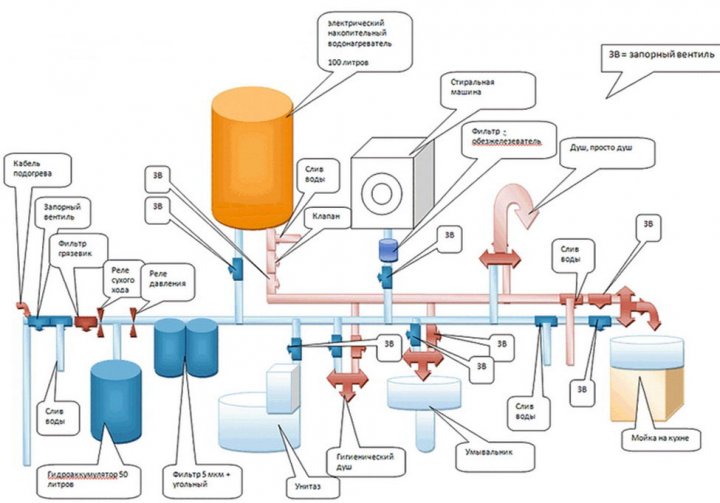
At each branch of the collector, an emergency repair valve is installed.
From the heating tank, which includes a check valve and emergency drain, water enters the hot collector, from which it is diverted to the sink, sink, shower, bath.
Pipe Materials
Now, mainly polypropylene pipes are used for wiring inside the house. We need only pay attention to the fact that polypropylene pipes for hot water supply have thicker walls and are equipped with reinforcement (PN25 marking). For cold water, pipes and PN20 are suitable.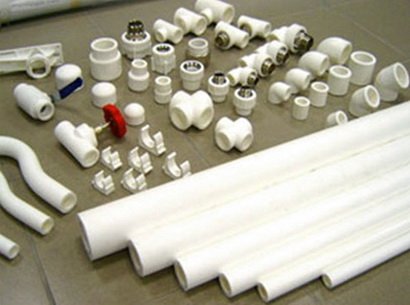
- Metal-plastic pipes differ not absolutely reliable connections with fittings, small mechanical strength, that's why they are not suitable for complex wiring.
- Copper pipes are extremely rare because of high cost.
- Steel pipes do not withstand competition with plastic by any parameters.
What pipe diameter for a water pipe should I choose?
The choice of pipe diameter should be determined hydraulic calculation. But such a complicated calculation boils down to the same results when it comes to household use. The calculation is very complicated, that's why it is simply ignored and use the worked out variants.The usual water flow through one tap is 5 - 6 l / min. Therefore, all the wiring in the house is made with polypropylene pipes with an external diameter of 20 mm, which is suitable for the capacity to connect several concurrent users, with a pipeline length of up to 10 meters.
(This capacity pipe is similar to a half-inch metal tube, or a 16-mm metal-plastic pipe)
But with a significant increase in length, the hydraulic resistance of the pipe also increases. It also increases with the increase in the number of turns, branches. Depending on the length, the following diameters (outer) of polypropylene pipes are suitable, for the usual water consumption of a house or apartment.
- Length up to 10 meters - pipes 20 mm.
- Length of 10 - 30 meters - a pipe of 25 mm.
- The length of more than 30 meters - pipes 32 mm.
A 25 mm pipe flows approximately 30 liters / min. without a significant increase in hydraulic resistance, if its length does not exceed 10 meters. Thus, a short manifold of 25 mm pipe provides 5 simultaneous-running cranes.
Pipe 32 mm - 50 liters / min.
Pipe 38 mm - 75 liters / min.
For the calculation, 4 concurrent users are usually accepted, - washer, a dishwasher, a shower cubicle, a toilet, a faucet.
The waterway to the house is usually made with a pipe of 25 - 38 mm depending on its length, technical recommendations for the pump installation and the accepted volume of the accumulator.
As you can see, nothing is complicated in the installation of a water pipe for the house there. Questions regarding the choice of the pump, its installation and connection, the adjustment of automation, the selection of the accumulator, you can learn as they come, or invite them to a qualified specialist. A drilling of walls, soldering polypropylene pipes, you can do it yourself.
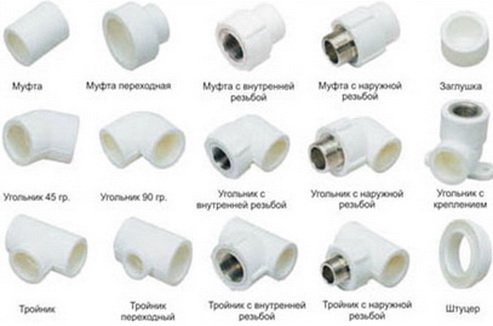
But before doing this, you need to draw a detailed pipeline diagram showing all the lengths and fittings. Without a circuit, even the simplest pipeline should not be taken.
Before you solder the pipeline, mark it on the wall (floor, ceiling) as it will be placed, where the fittings will be, where there should be crossings through the wall, measure the distances and determine the pipe lengths, taking into account the sealing in the fittings. This will reduce the probability of marriage and mistakes and will greatly speed up the work.
Video about the installation of a water pipe in a private house.


